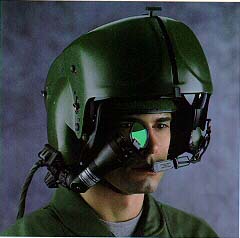Helmet-mounted display
| Helmet-mounted display | |
|---|---|
 |
|
| The Integrated Helmet and Display Sight System (IHADSS) |
A helmet-mounted display (HMD) is a device used in some modern aircraft, especially combat aircraft. HMDs project information similar to that of head-up displays (HUD) on an aircrew's visor or reticle, thereby allowing them to obtain situation awareness and/or cue weapons systems to the direction his head is pointing. Applications which allow cuing of weapon systems are referred to as helmet-mounted sight and display (HMSD) or helmet-mounted sights (HMS). These devices were created first by South Africa, then the Soviet Union and followed by the United States.
Aviation HMD designs serve these purposes:
HMD systems, combined with High Off-Boresight (HOBS) weapons, results in the ability for aircrew to attack and destroy nearly any target seen by the pilot. These systems allow targets to be designated with minimal aircraft maneuvering, minimizing the time spent in the threat environment, and allowing greater lethality, survivability, and pilot situational awareness.
In 1962, Hughes Aircraft Company revealed the Electrocular, a compact CRT, head-mounted monocular display that reflected a TV signal onto a transparent eyepiece.
The first aircraft with simple HMD devices appeared for experimental purpose in the mid-1970s to aid in targeting heat seeking missiles. These rudimentary devices were better described as Helmet-Mounted Sights. Mirage F1AZ of the SAAF (South African Air Force) used a locally developed helmet-mounted sight. This enables the pilot to make bore attacks, without having to maneuver to the optimum firing position. South Africa subsequently emerged as one of the pioneers and leaders in helmet-mounted sight technology. The SAAF was also the first air force to fly the helmet sight operationally. The US Navy's Visual Target Acquisition System (VTAS), made by Honeywell Corporation was a simple mechanical "ring and bead"–style sight fitted to the front of the pilot's helmet that was flown in the 1974–78 ACEVAL/AIMVAL on U.S. F-14 and F-15 fighters
...
Wikipedia
